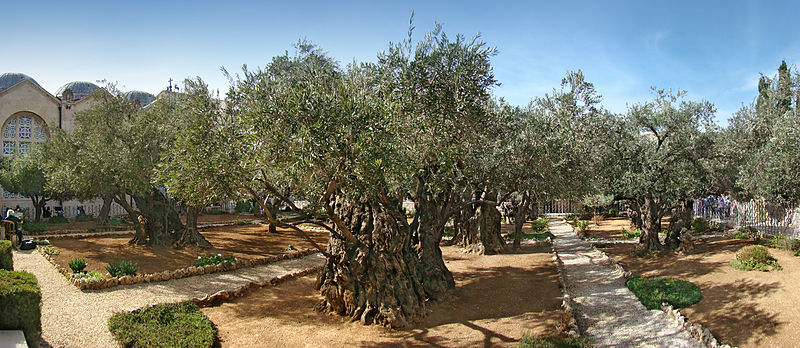Garden of Gethsemane
Gethsemane (Greek: Γεθσημανή, Gethsemane; Hebrew: גת שמנים, Gat Shmanim; Syriac: ܓܕܣܡܢ, Gaḏ Šmānê, lit. “oil press”) is a garden at the foot of the Mount of Olives in Jerusalem, most famous as the place where Jesus prayed and his disciples slept the night before his crucifixion.
According to the New Testament it was a place that Jesus and his disciples customarily visited, which allowed Judas to find him on the night of his arrest.
Pilgrimage site
According to Luke 22:43–44, Jesus’ anguish on the Mount of Olives (Luke does not mention Gethsemane; Luke 22:39-40) was so deep that “his sweat was as it were great drops of blood falling down to the ground.” According to the Eastern Orthodox Church tradition, Gethsemane is the garden where the Virgin Mary was buried and was assumed into heaven after her dormition on Mount Zion. The Garden of Gethsemane became a focal site for early Christian pilgrims. It was visited in 333 by the anonymous “Pilgrim of Bordeaux”, whose Itinerarium Burdigalense is the earliest description left by a Christian traveler in the Holy Land. In his Onomasticon, Eusebius of Caesarea notes the site of Gethsemane located “at the foot of the Mount of Olives”, and he adds that “the faithful were accustomed to go there to pray”. Eight ancient olive trees growing in the Latin site of the garden may be 900 years old.
Olive trees
A study conducted by the National Research Council of Italy in 2012 found that several olive trees in the garden are amongst the oldest known to science. Dates of 1092, 1166 and 1198 AD were obtained by carbon dating from older parts of the trunks of three trees. DNA tests show that the trees were originally planted from the same parent plant. This could indicate attempt to keep the lineage of an older species intact. Then again the three trees tested could have been sprouts reviving from the older roots. “The results of tests on trees in the Garden of Gethsemane have not settled the question of whether the gnarled trees are the very same which sheltered Jesus because olive trees can grow back from roots after being cut down”, researchers said.
However Bernabei writes, “All the tree trunks are hollow inside so that the central, older wood is missing . . . In the end, only three from a total of eight olive trees could be successfully dated. The dated ancient olive trees do, however, not allow any hypothesis to be made with regard to the age of the remaining five giant olive trees.”[13] Babcox said that the roots of the oldest trees are possibly much older and then points out the traditional claim that the trees are two thousand years old.
Source : wikipedia
https://www.youtube.com/watch?v=VLlN8e7WiRk
https://www.youtube.com/watch?v=vCxubx6M3cQ
https://www.youtube.com/watch?v=10b-mbQ7FUw
Reviews
https://goo.gl/y1IlPn



Rate this article